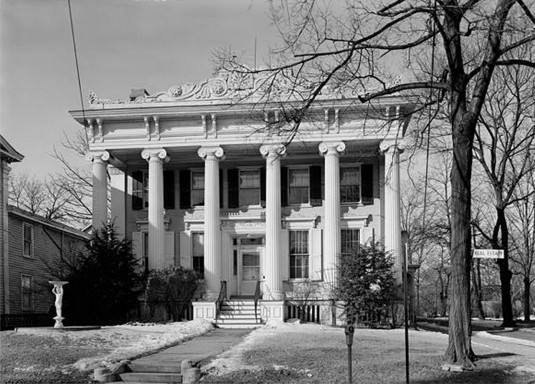
Beautiful, isn’t it? One of the most extraordinary buildings to be found in Flemington, a town with more than its share of great old buildings. It is an outstanding example of Greek Revival architecture.1
The building was constructed in 1847, toward the end of the Greek Revival period in American architectural styles. Greek Revival became popular in America in the 1820s, partly inspired by Greece’s struggle for independence. To many Americans, Greece was the original home of democracy, and in the 1820s, America’s experiment in democracy was only about 50 years old. Americans felt a solidarity with the Greek people, and expressed it by adopting the style of early Greek buildings for their new homes and institutions.
By 1847, the fashion was turning toward what became known as the Victorian style, so you might say that the architect of the Fisher-Reading mansion was a little behind the times. Inside the house, one can definitely find Victorian influences. But, one might also say that this is an example of the Greek Revival in its mature phase.2
The Building Today
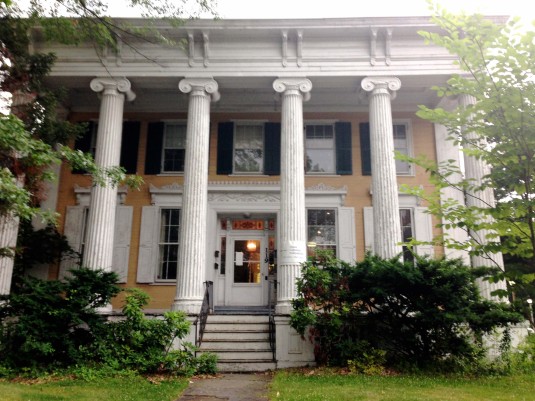
The photograph above was taken when the house was still in its glory. Today it is distressing to see how far it has fallen from its original beauty. Will it be lost? That would be terrible. It is too important a part of Flemington’s history for it to be allowed to crumble and fall. It would also be tragic if the details that make it so distinctive are not repaired carefully. Too often, old buildings are stripped of the old trim work that make them so distinctive, and they end up looking rather pitiful.
I have a personal interest in this building. When my husband, Dick Zimmer, was serving in the New Jersey legislature, he had an office on the second floor. For a few years, he sent out a Christmas card using one of the HABS drawings, on file with the Hunterdon County Historical Society. Now you can really see what makes this building so special.
The Client
Much has been written about the architect of this marvel, and I will add my two cents below. But first, I’d like to write about the person for whom this house was built.
Col. James Newell Reading, Esq. was born August 8, 1808 to Joseph Reading and Eleanor Grandin, at the home of his maternal grandfather, Dr. John F. Grandin, in Lebanon Township, and was named for his grandmother’s father, Dr. James Newell.3 Joseph Reading and Eleanor Grandin married in 1804. Of their seven known children, James N. Reading was the oldest.
Reading studied law under Flemington attorney, Charles Bartles, Esq. and graduated from Princeton University in 1829. Afterwards, he studied law with Samuel Southard, Esq. in Trenton. (Southard had previously practiced law on Flemington’s Main Street.) Reading was admitted to the Bar in 1832 and became a Counselor-at-Law in 1836.
James N. Reading was an early and staunch supporter of the Whig party in Hunterdon. As early as 1834 he was one of the Amwell delegates to attend the state convention in Trenton. And he was elected president of the “Whig Young Men’s Meeting” of Amwell, which at the time included Flemington, Raritan, Delaware, Lambertville, and East & West Amwell.
That same year (1834) he was named clerk to the Board of Freeholders. Was this a political job? I cannot say. In 1834, each town could send two freeholders to the county. There were eleven towns, which meant 22 freeholders, surely a rather unwieldy group. Some of them were Whigs, but many were Jacksonian Democrats. This was the only year that Reading served as Clerk.
On February 18, 1835, James N. Reading, Esq. of Flemington was married to Sarah Celia Almira Southard in Somerville.4 She was the daughter of Samuel Southard’s brother, Isaac Southard, Esq., and Mary Wright Doty. James and Sarah Reading had five children, including a son Joseph who died on January 29, 1845 age 8 months.
During the years he practiced law in Flemington (1832-1850), Reading served as county prosecutor in 1837, as Deputy Attorney General in 1847, and as Master in Chancery in the mid 1840s. He frequently appeared in the Hunterdon Gazette acting as an agent, an administrator, an assignee and a collector of debts. In 1837 he was serving on the board of directors of the Raritan Manufacturing Co.; in 1848 he was an agent for the Equitable Life Insurance Co. In 1850, he was on the board of the Mammouth Mining Co.
Reading continued to be active in the Whig Party in the 1840s—that was when the party was at its peak. He was often called on to speak to local branches of the party, frequently attended conventions in Trenton, and was elected annually to the party’s “Committee of Correspondence” for the party. In 1848 he helped establish a Whig “Rough and Ready Club.” Zachary Taylor was running for president that year; he had gotten the nickname “Old Rough and Ready” during the Seminole War in the late 1830s.
Reading acquired the title Colonel from his service in the 3d Regiment of the Hunterdon Militia Brigade, and regularly called for Officers’ Drills. He was named to head up the “Flemington Greys” in 1844, which marched in 4th of July parades and during celebrations of Washington’s crossing the Delaware River.
Reading had a public spirit also. He joined with others in 1839 to raise funds to support the Flemington fire company; he helped to draft the constitution and by-laws for the first Hunterdon County Agricultural Society; he was on the executive committee of the Hunterdon Temperance Society in 1846; helped to raise funds for those suffering in Ireland and Scotland from the potato blight; and was even given as a reference for the Young Ladies’ Institute of Somerville.
And he had a green thumb! In 1841, at the H. C. Exhibition & Fair, he was given a “premium” for 109 bushels of beets on a half acre. One June 20, 1849, the Gazette declared:
“STRAWBERRIES.─Our friend, James N. Reading, Esq., presented us with a dish of excellent Strawberries a few days since, which grew in his garden, one of which measured 4 & 1/8 INCHES in circumference ! We think this is decidedly ‘some pumpkins,’─no, not exactly a pumpkin, but in a fair way to have made one. If our brethern [sic] of the Press can beat it, let them “fetch” us a dish of the “proof,” and we’ll knock under !”
By 1847, James N. Reading was ready to inhabit a large impressive house in Flemington. But he needed a good architect.
The Architect

Mahlon Fisher5 was born in Alexandria Township on February 10, 1810 to Joseph Fisher and Elizabeth Leonard. Joseph and Elizabeth were married by Rev. Holloway W. Hunt on February 20, 1808.6
I believe that Joseph Fisher was a descendant of Johannes Peter Fisher (c.1698-1775) and Anna Maria Young (1701-c.1775), and his maternal grandparents were Derrick Hoagland (c.1700-c.1765) and Mary Van Kirk. Eleanor Leonard’s grandparents were Paul Leonard (c.1720-1778) and Mary Alice Kitchel.
Cornelius W. Larison wrote “Skech of the Fisher family of old Amwell Township in Hunterdon County, N.J.” in 1890. (You can find this on Google Books, but be forewarned, it’s written in Larison’s “fonetic” style, which is very challenging to read.) According to Larison, Joseph and Eleanor Fisher had only two children, sons Mahlon and Johnson.
Fisher’s Life in Flemington
Mahlon Fisher’s beginnings were modest. He did not go to Princeton the way his client, James N. Reading, did. But he got the education he needed by apprenticing at the age of 16 with a carpenter/builder.7
On January 30, 1834, Mahlon Fisher married Mary Ann Stires (1811-1873), daughter of John S. Stires and Sarah Smith of Readington, later of Flemington. Rev. Charles Bartolette officiated. They had eight children between about 1835 and 1847, only one of whom died as a child.
By December 24, 1834, Mahlon Fisher had gone into business for himself. According to Meginness, he began his career “with no capital but unfolded talents and his unflinching integrity.” Here is his advertisement published in the Hunterdon Gazette:
CABINET MAKING In Flemington. The subscriber respectfully informs the public, that he has taken the shop in Flemington next door to the Methodist Meeting-house, where he is carrying on the CABINET MAKING business in its various branches. He will make to order, Mahogany Sideboards, Pillar and Claw Tables, Bureaus, Secretaries, &c. &c. in the best manner. Also, BEDSTEADS of different kinds. Having on hand a supply of the best seasoned stuff, he will be able to accommodate customers at short notice. He will also make COFFINS of various descriptions, at the shortest notice. As he hopes by diligent attention to his business to give satisfaction to those who may favor him with their custom, he solicits a share of public patronage. [signed] Mahlon Fisher. Flemington, Dec. 24, 1834.
Fisher made a practice of inserting an ad for his cabinet shop in the Gazette once a year, in December. In 1835 he had hired “two good journeymen,” which allowed him “to make up work to order,” such as “Sideboards, Bureaus, Tables, Bedsteads, &c. will be made at the shortest notice, and in the best manner.” Then in 1836, he notified the public that he had moved to a new location, “opposite N. Price’s Tavern, in Flemington, where he will continue to make Cabinet Ware of every kind to order, such as Mahogany and Cherry Bureaus, Pillar and Claw Dining Tables, Breakfast Tables, Work Stands, Bedsteads, &c. &c.”
Fisher had ambitions to be more than just a cabinet maker. He wanted to build houses. To prepare for this line of work, he studied the well-known book called The Antiquities of Athens and Other Monuments of Greece by James Stuart and Nicholas Revett. It was published in several volumes, the first in 1762, and the last in 1816, when it helped to launch the Greek Revival fashion in Britain and then in America. Students of 19th-century architecture have found that many of Fisher’s techniques came from this book.
As “The History Girl” has written (“Leaving His Mark in Flemington“), Hunterdon County was not very developed in the 1830s. But, as editorials in the Hunterdon Gazette indicate, the spirit of development was blossoming by the 1840s. And Flemington, as the county seat, was home to all those who had business with the county government, i.e., lawyers, accountants, merchants. Once the hardships of the Panic of 1837 had subsided and they began to prosper again, they were ready to show off a little.
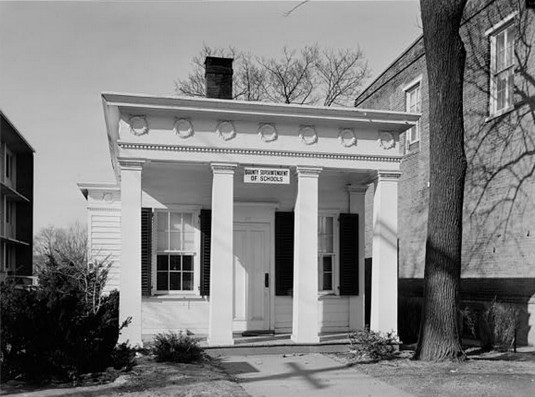
One of his first commissions appears to have been for Alexander Wurts, Esq., a Flemington attorney who had bought the office previously occupied by Samuel Southard, located at 59 Main Street, next to the Hall of Records. The building had been standing since around 1812 when Southard began his practice. Wurts moved in around 1820, and after a couple decades, the building was ready for an upgrade to the popular Greek Revival style. Fisher added a portico with four square columns and a frieze decorated with carved wooden wreaths.
In the 1830s, Mahlon Fisher began investing in Flemington real estate. The first deed recorded for him was dated September 7, 1836, when he bought a half-acre on Spring Street from Wm. F. Clemson for $100.8 This lot was probably adjacent to the home of his wife’s parents. Clemson was an associate of James N. Reading.
On February 11, 1842 Mahlon Fisher bought a half-acre lot on the east side of Main Street from William H. Sloan, Esq. for $430, bordering land of Charles Bartles.9 This was eventually where he built the Doric House, at 116 Main Street.
On April 13, 1843, Mahlon Fisher bought a half-acre lot on Spring Street from his father and mother-in-law, John S. and Sarah S. Stires, for $134. It bordered the lot he already owned, as well as Neal Hart and Hugh Capner.10
It was also in April 1843 that Mahlon Fisher was elected a Chosen Freeholder for Raritan Township (which included Flemington). Clearly by this time, Fisher had made a name for himself. The next month he was one of the commissioners attempting to raise funds to repair the Flemington Academy. Fisher had four children by this time, and needed to consider their education.
On October 3, 1843, Mahlon Fisher filed a Building Contract to build a frame house for Tunis Sargent.11 The location is not known, but I do wonder if it might have been on Spring Street. A deed search might answer that question. This was the first of the building contracts recorded for Fisher, but not every house built by Fisher had a recorded contract.
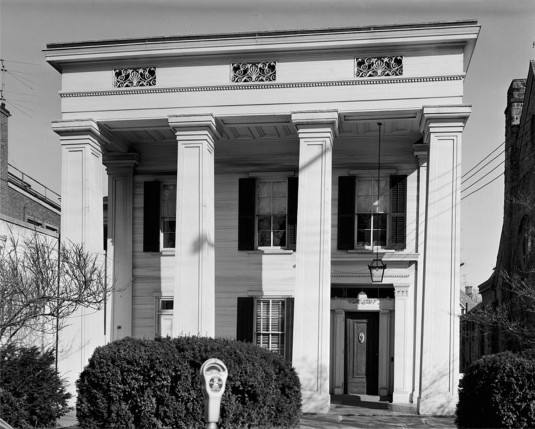
On November 14, 1845, Fisher recorded a building contract to employ William Clark for masonry work on a house that “Fisher is about to erect in Flemington.” This was his very attractive Greek Revival house on the lot purchased from William H. Sloan, known today as the Doric House and owned by the Hunterdon County Historical Society. Like the Wurts Law Office, this building featured square columns and a large entablature. Mahlon Fisher and his family had been living on Spring Street until this lovely new home was constructed.12
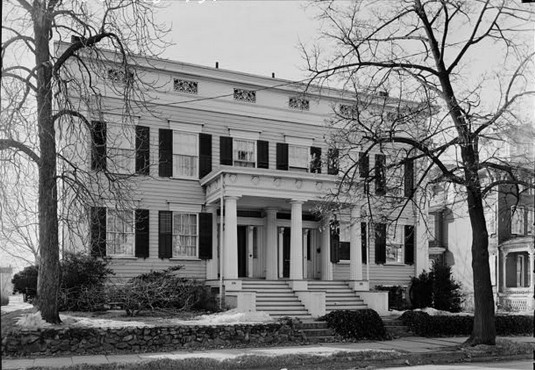
In 1845, Mahlon Fisher retired from the Board of Freeholders and was instead named County Collector, a position he held through 1847.13 Also in 1845, Fisher was hired to build a house for the brothers John G. and Joseph H. Reading, brothers of James N. Reading. This was a double house located at 151-153 Main Street, now known as the Dorf House. The porch has fluted Doric columns and a large entablature, similar to the Wurts Law Office and the Doric House. An interior wall ran between the two houses, each half with three windows along the front, and each with its own front door. This was an important commission for Mahlon Fisher.
Fisher then built a smaller house at 21 Mine Street for Richard S. Kuhl, Esq., another Flemington attorney who later became a State Senator. This time, Fisher switched to round Ionic columns, a style he also used on the James N. Reading house.
Back to the Owner
John G. Reading (1812-1891) and Joseph H. Reading (1814-1857) were the younger brothers of James Newell Reading (1808-1884). Very soon after their double house was finished, Fisher went to work for their brother James Reading. It appears that James was prepared to outdo his brothers in a big way.
On April 1, 1847, James N. Reading, Esq. of Flemington purchased a lot of 2.02 acres on Main Street, Flemington, that is, “the street through Flemington,” from Charles Bartles and wife Eliza for $3,474.14 This was adjacent to Bartles’ home property, and the deed contained an interesting exception; a six-foot-wide alley running along the border with Bartles was to be set aside, and Bartles would do the same on his lot in order to create a 12-foot-wide alley to run between the two lots and be shared by them. They were also to share the expense of building and maintaining a gate to the alley.
This lot was located on the corner of Main Street and Mine Street. In previous years, it had been the location of Nathan Price’s tavern. In 1822, a map of Flemington shows Charles Bartles’ lot a little further down Main Street. It is No. 13 on the map, which was “residence of William Maxwell. It constitutes the main part of the present residence of Charles Bartles, Esq.” And for the location of the Reading mansion, #14, “an old house belonging to Nathaniel Saxton, and since removed. It was on the site of Dr. Parish’s residence.”15 So, the house displaced some older buildings.
James N. Reading and Charles Bartles had a long-standing relationship, ever since Reading began to study law as a young man. In 1847, Reading was about 40 years old, and Bartles was only seven years older. Charles Bartles was becoming exceedingly rich. In 1850, he was worth twice as much as James N. Reading, with property valued at $48,000.
Not long after the house was finished, James N. Reading grew restless. In 1850, he took on a partner named Theodore E. Chapman. This was announced in the Gazette of October 9th, with the statement that the partnership was “ready to attend to professional business.” But in fact, Reading may have been getting ready to do something else—leave Hunterdon altogether. In fact, he had given notice back on June 5, 1850 that Mr. T. E. Chapman would remain in the office while Reading was visiting St. Louis “for a few weeks.”
A year later, on October 15, 1851, he announced in the Gazette that his brother, John G. Reading, would be attending to his business “during my approaching temporary absence in Missouri.” The office was located
“in the basement of my residence in Flemington. In the absence of my brother from the office, any business papers or notices may be left with Col. John Chapman. [signed] James N. Reading.”
I have not been able to determine if John Chapman and Theodore E. Chapman are related, but it would be surprising if they weren’t.
By 1853, Reading had relocated his family to Illinois. There he entered politics and in 1856, was elected to the Illinois State Legislature, no doubt as a Whig. (This was Lincoln country after all.) In the 1860 census the family was living in Chicago. James N. Reading was 51, a lawyer, with property worth $14,300. His wife identified herself as Cecilia Reading age 45. The children were Ella 20 and Henry 18.
It is clear that Reading was missed by his friends back in Hunterdon. Here is what the editor of the Gazette (Willard Nichols) wrote of him in the March 11, 1857 edition of the Hunterdon Gazette:
“We [Willard Nichols, ed.] are further greatly gratified to learn through a private correspondent that our former distinguished fellow-townsman, Col. James N. Reading, occupies a prominent position in the Illinois Legislature. Our correspondent says, “Col. Reading’s speech on the bill amending the banking law, was listened to with profound attention, and was admitted by all to be the best effort by far made on that occasion. Depend upon it, high honors await this distinguished Jerseyman at the hands of the discriminating people of Illinois. An eminent banker of Springfield, who is also a native of Hunterdon county, at the conclusion of Col. Reading’s speech, said that he felt proud that his native county had so able a representative in the person of our mutual friend, Col. J. N. Reading!”
In 1870, the family was settled in their final home, in the town of Morris in Grundy County, Illinois. Soon afterwards, he was made a Judge of Grundy County. In 1880, James was still a practicing attorney even though he was 71. His 38-year-old son Henry was a clerk in a dry goods store, widowed with two children.
Reading had not forgotten his friends in Hunterdon. He visited there in 1881. Three years later, the Hunterdon Republican printed his obituary (on June 18, 1884):
“Died At Morris, Grundy county, Ill., June 8th, 1884, Hon. James N. Reading, formerly of this county, aged 75 years and 10 months. Col. James N. Reading, who left Flemington some thirty years ago, for Morris, Grundy county, Illinois, died at his home there on the 8th inst, and leaves a wife Sarah C. Reading. He was born at Hamden in 1808 and studied law under Charles Bartles Esq., now deceased. He graduated from Princeton College in 1829 and was admitted to practice law in 1832, settling in Somerville for 3 years before moving to Flemington. He moved to Morris, IL, in 1853, where he died. He served in the State Legislature from 1856 to 1858 and was a Judge of the Grundy County Courts for 12 years.”
The Rest of Mahlon Fisher’s Life
Not long after building James N. Reading’s mansion, Mahlon Fisher gave up the architecture business and turned instead to lumbering. During the mid-19th century there was a lot of money to be made cutting and selling timber. In 1848, Mahlon Fisher joined in partnership with his brother Johnson Fisher to set up a lumber business in Stockton. Mahlon Fisher purchased the property of Asher Johnson there in 1849. He sold his house in Flemington and moved to a 1.39-acre lot on Johnson’s land, and sold the rest to Charles Bartles and Aaron Van Syckle.
In 1850, he was a 40-year-old ‘lumberman’ living in Stockton with wife Mary A. Reading, age 39, and six children: Anna J. 14, Sarah E. 12, William S. 11, Alfred 9, Mary H. 7, and George W. Fisher age 3. He had property worth $3,000. In 1855, seeing more opportunity further west, he moved to Williamsport in Lycoming County, Pennsylvania, where he spent the rest of his life and prospered. In 1870, he had property worth $90,000; not quite as rich as Charles Bartles was by then, but much wealthier than his old client, James N. Reading.
But Charles Bartles was definitely helpful when joined with John G. Reading and Mahlon Fisher to purchase large tracts of timber land in Pennsylvania, this according to the obituary for Charles Bartles, published in the Hunterdon Republican on June 20, 1883.
A long tribute to Mahlon Fisher was published in a Lycoming County history, calling Fisher “Architect-Entrepreneur-Philanthropist.”16
Having learned while living in New Jersey of some extensive coal and timber lands in western Pennsylvania which others had failed in an attempt to develop, he determined to risk his all, and became a third owner of the vast territory which he proposed to develop. His life thus far had been stamped with the seal of honor, and among the friends of his boyhood he had no trouble to find those who, with unstinted confidence in his ability, were ready to contribute and risk the means required to bring forth the hidden treasures of the forests which placed him, as well as those connected with him, in positions of ease and opulence.
At the time of his death he was connected with many business interests of Williamsport, being president of the Susquehanna Boom Company and the Valentine Iron Works. He was largely interested in the lumber firms of Reading, Fisher & Company, Teneyke, Emery & Company, and the planing mills of Reading, Fisher & Reading. He was one of the organizers and a director of the old Lumberman’s National Bank, and was one of the original members of the Williamsport Land Company.
He cast his first Republican vote for Abraham Lincoln and served one term as county treasurer while living in New Jersey. He also held other offices of minor importance.
Mahlon Fisher was the artificer of his own life, and was one of the few men who became rich and yet maintained a reputation spotless and unsullied. Truth, honor and fidelity was the platform on which he stood firm and unmovable. His generosity was without stint. According to the sixth item of his will he provided that his executor shall invest $30,000 in Pennsylvania State bonds, and turn the same over to the trustees of the First Baptist church in trust, the larger part of the interest on said bonds to be paid to the widows and orphans of Williamsport who have been made such while residing in that city, regardless of race, color, or religious denomination. The interest has amounted to about $1,000 per year, and is distributed semi-annually by the treasurer of the Baptist church.
Mahlon Fisher died of typhoid fever on December 28, 1874. The Hunterdon Democrat also acknowledged his passing with special attention to Mrs. Fisher, who had died on June 3, 1873.
“In 1834 he [Mahlon Fisher] was married to Miss Stires, who shared with him the trials and struggles of his young life and his toiling hours, as well as the luxury and opulence of declining years, until 1873, when her gentle spirit seemed to be wafted to the better land by the soft zephyrs of the June morning.”
Back to The Mansion
There is much more to the story of this wonderful house, but time and space have prevented me from discussing its subsequent owners.
If someone does not purchase and restore this architectural marvel soon, we will lose it, and with it will go a very important part of Flemington’s and Hunterdon’s history. This desperate situation is matched down the street by the sad state of the Union Hotel.
Yes, it takes more work and more money to maintain a building like this—no question about it. Perhaps it is already too late. I hope not. It’s time to bring these buildings back to life. By doing so, the spirit of Flemington will also be rejuvenated.
Addendum: You can get a good look at the HABS photographs at the Library of Congress website. Also, on page 673 of the Hunterdon Historical Newsletter of the Hunterdon Co. Historical Society, there is a lovely reproduction of a detailed drawing from HABS of one of the Ionic columns. Also an article on the Fisher portraits (Mahlon, his wife Mary Ann, their son John S. Fisher and his wife Elizabeth Jennison) appears in the Fall 2009 issue of the HHN, p. 1071. And in the Fall 2000 issue of the HHN, pp. 849-850, there is an article titled “Future Home of HCHS? Reading-Large House.” There was a time when the HCHS considered purchasing the property to provide space for the burgeoning archives. But it did not come to pass.
Correction: The original version said that John N. Reading married Sarah Southard, when, of course it should be James. Also, I had mistakenly written that John G. Reading shared a house with his brother Philip G. Reading, when in fact, the brother was Joseph H. Reading. Brother Philip went to live in Frenchtown.
Footnotes:
- I will refer to the Historic American Buildings Survey hereafter as HABS. ↩
- One of the best books on the subject is Greek Revival America by Roger G. Kennedy, 1989, with stunningly beautiful photographs, including one of the old Southard Law Office at 59 Main St. ↩
- Snell, History of Hunterdon County, p. 209. ↩
- Hunterdon Gazette, Feb. 18, 1835. ↩
- Fisher has been written about several times in the past. I recommend a paper presented to the Hunterdon County Historical Society by Frances Blomquist, “Mahlon Fisher, Provincial Genius,” an abstract of which was published in the Hunterdon Historical Newsletter, 1969, vol. 5, no. 1, p. 67. Also see “Leaving His Mark in Flemington: The Architecture of Mahlon Fisher,” by ‘NJ Historian,’ on The History Girl website. Portraits of Mahlon and wife Mary Ann can be seen at the HCHS building on Main St., also of their son John S. Fisher and wife Elizabeth Jennison; see also Hunterdon Historical Newsletter, p. 1071. ↩
- Hunterdon Co. Marriages, Book 1 p. 148. ↩
- This according to the History of Lycoming County Pennsylvania by John F. Meginness, 1892, pp. 706-707, available on Google Books. It does not identify the “carpenter/builder” that Fisher apprenticed for. ↩
- H. C. Deed Book 66, p. 181. ↩
- H. C. Deed Book 79, p. 023. ↩
- H. C. Deed Book 88, p. 13. A building contract was recorded as an agreement to sell a house owned and built by Mahlon Fisher on Spring Street. I do not have the exact date. See Building Contract No. 41. This was Fisher’s third contract. ↩
- Hunterdon County Building Contract No. 24; hereafter HCBC. ↩
- HCBC No. 32. I have not identified which house on Spring Street belong to Mahlon Fisher; a project for another time, perhaps. ↩
- Snell’s History of Hunterdon, p. 265. ↩
- H. C. Deed Book 88, p. 210. ↩
- Snell, p. 21-22. ↩
- Meginness, pp. 706-707. ↩
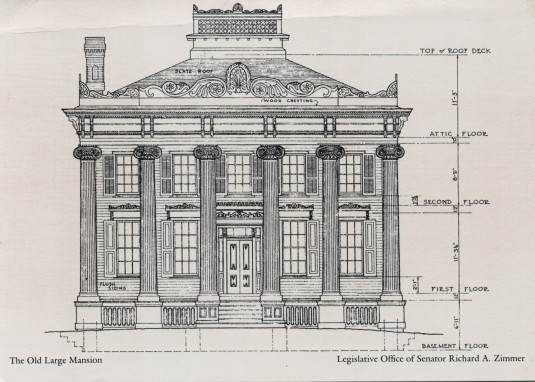
Ben Zimmer
August 16, 2015 @ 3:22 pm
The mansion is now better known as the Reading-Large House. George H. Large owned it from 1900 and established a law firm there with his son George K. Large. (Large & Large was later known as Large, Scammell & Danziger.)
Fun fact about George H. Large: he was the oldest surviving participant of the first-ever college football game (the 1869 Rutgers-Princeton game). See his Wikipedia page for more.
Vivian Reading
March 15, 2017 @ 5:56 pm
I would like to know if there has been an effort to restore the Reading-Large home?
Marfy Goodspeed
March 16, 2017 @ 8:57 am
Vivian, I am happy to report that the Hunterdon Co. Chamber of Commerce has taken over the building and is in the process of restoring it. And not a moment too soon.
Goodspeed Histories: How one person changed a town…
March 16, 2021 @ 1:03 pm
[…] process of doing research for this story, I discovered an error in my previous article on the “Fisher-Reading Mansion,” which I have since corrected. Since no one seems to have noticed it, I will say no more, but […]